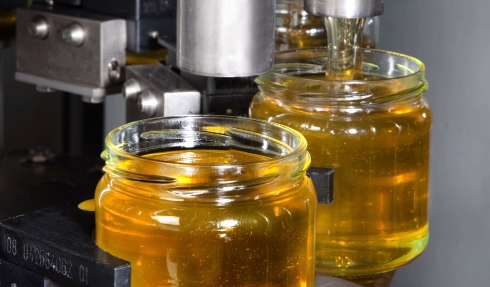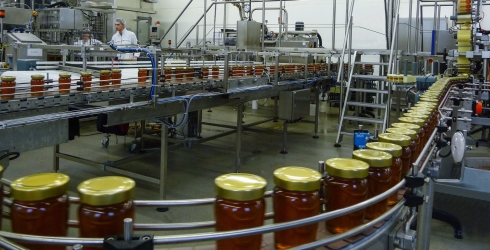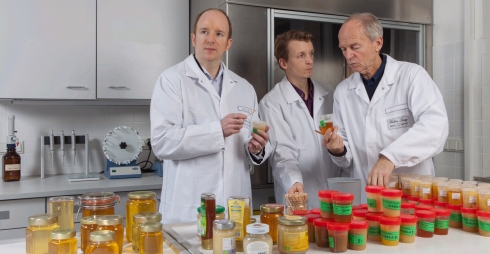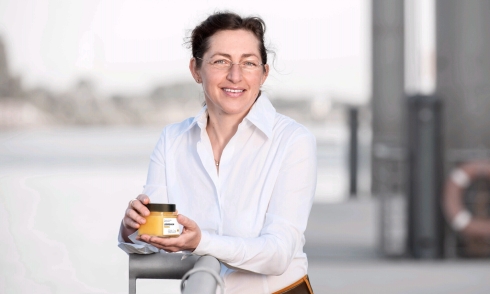|
|
| |
|
|
| |
|
|
| |
Happy New Year!
We hope you got the new year off to a good start and
wish you a profitable and very successful 2016. We also hope you
continue to express a great interest in the topics in our
newsletter and look forward to some promising collaboration on all
sides. |
|
| |
|
|
| |
Pure packaging for a pure product
NEWS +++ Liquid gold, the nectar of the gods ... there
are many descriptions for honey, most of them very exaggerated,
all of them positive. After all, honey is regarded as one of the
purest foods around. Unlike sugar, it has the advantage that it
already contains many substances which help the human body to
digest the sugar it contains. It helps to heal wounds, has an
antibacterial effect, protects the body’s cells and renews them.
Inflamed gums can be alleviated by honey while it can also relieve
the symptoms of colds by clearing the sinuses and reducing coughs.
Honey is regarded as a beauty and anti-aging product and, last not
least, it simply tastes good.

In Germany, around 1.2 kilos of honey are consumed per
capita each year. Courtesy of a million hives. For approx. 300
grams of honey, each individual bee is obliged to leave the hive
around 20,000 times, flying from blossom to blossom to collect
nectar. After visiting approx. 1,500 blossoms, it returns
heavily-laden with a sweet load to the hive where it passes its
treasure on to a colleague, the so-called house bee. As it sets
off on its homeward flight, the nectar begins its exciting
transformation into honey as the bee enriches it with valuable
substances such as enzymes. Inside the hive, the bees extract more
water from the nectar and store the honey drop by drop in the
honeycomb which they cover with a fine layer of wax. And then the
beekeeper uses centrifuges to eject the honey, before filtering
it, passing it through a sieve and pouring it into jars.
A product as pure as this requires equally pure
packaging. Choosing glass as a container is a good solution as
glass is regarded as healthy and safe packaging, considering the
fact that it is impermeable and practically eliminates the
possibility of interaction with the contents. It satisfies all
requirements which packaging should focus on, i.e. maintaining
both the intrinsic quality of food and extrinsic demands on
quality. Glass therefore complies with one of the more pressing
tasks of guaranteeing both shelf life and toxicological safety by
minimizing interactions between the packaging material and the
food contained therein. For some years now, this has also applied
for the glass closure, the metal lid, by preventing migration from
the lid sealants into the contents. What was already solved
decades ago for the beverages industry is also possible for
wide-mouth closures and therefore for glass jars. Using TPE
technology originally developed by ACTEGA DS for crown corks and
aluminum closures, it has been possible to close an essential gap
in the elimination of PVC from packaging coming into contact with
food.
In the form of PROVALIN®, the market offers a closure
sealant compound free of PVC and phthalates which complies with
all EU guidelines and guarantees maximum food safety. The various
models mean that there are suitable solutions available for all
food packaged in jars and bottles – including for honey.
|
|
|
|
 ORGANIC
PIONEER ORGANIC
PIONEER
|
|
|
|
News +++ One company relying on this closure solution is
represented by Europe’s largest importer of organic honey, Walter
Lang GmbH, whose roots extend back to 1895 when honey was first
imported to its location in Bremen. Walter Lang GmbH evolved from
Walter Lang Honigimport GmbH in 2008 and specializes in the
production, manufacture and distribution of organic honey.

As an organic pioneer, Walter Lang delivered his first
home-centrifuged honey to regional organic stores more than 40
years ago and was involved in developing the guidelines governing
ecological beekeeping more than 30 years ago. Today, its employees
pass on their experience concerning sustainable, biological and
resource-conserving production to beekeepers in the
honey-producing countries on each continent of the globe. Of the
eight million kilos of honey which are on average imported every
year, around 85 percent is accounted for by organic honey.
Additionally, the “Walter Lang-Spezialitätenhonige” brand
featuring 35 selected blends – from cherry blossom honey from the
Kassel Hills to Maya honey from Yucatan in Mexico – has been sold
since 2013. |
|
|
|
 PRODUCTION PRODUCTION
|
|
|
|
Careful processing
and filling
NEWS +++ Before the
honey can be poured into jars, it requires careful preparation,
i.e. diligent purifying, sieving and creaming. Purification
without compromising quality is of particular importance during
the processing stage. The honey enters a heat chamber from where
it runs through a spiral, is briefly heated, filtered and cooled.
To ensure that the honey does not incur any damage and all
valuable components are retained as best as possible, each work
stage is monitored: comprehensive monitoring of the temperature,
checking the pressure in the pipes during conveying, adjusting the
rotating speed of the agitator in the tank.
The stringent
guidelines outlined by the IFS ensure a high standard of quality
assurance. In the company's own honey laboratory, qualities are
tested and documented in collaboration with Germany's only
institute for honey analysis. On average, 200 individual samples
are examined every day.

After processing,
the honey is then ready for bottling. This is also carried out
carefully and gently in a modern filler which slowly doses the
honey into the jars. In its state-of-the-art production
facilities, Walter Lang GmbH avails of one of the most modern
filling and packaging plants in Europe. Technology can be adapted
to individual customer demands. The jars are then sealed and
labeled.
What is important
at this point is that the closures only contain sealants which are
free of PVC and phthalates, i.e. PROVALIN®, which is a sealant
compound based on thermoplastic elastomers. This also goes well
with the company's philosophy in which major attempts are always
made to trigger as little environmental impact as possible during
manufacture, packaging and storage of the products.

Karin
Lang, Dipl-Ing. Food technology, QMB, Walter Lang GmbH and
Sonnentracht GmbH, Bremen:
“We have been
filling organic honey specialties into glass jars for the organic
food trade since 1974. As an organic pioneer, we have always
attached maximum importance to the selection of blends and their
unique flavor as well as the naturalness of our honey varieties.
But we regard the suitability and handling features of packaging
material to be of equal importance to product quality. In the Blue
Seal lid, we are now using a migration-free compound for our
twist-off lids enabling us to promote our products as having
“PVC-free packaging”. This is a decisive improvement for
environmentally-conscious consumers concerned with sustainability.
Meanwhile, we now fill more than 24 million jars and PET bottles
in the private label sector each year enabling us to satisfy our
customers’ high demands. We are delighted with this innovative
development by Actega which – like us – has its headquarters in
the beautiful Hanseatic city of Bremen thereby making an active
contribution toward a clean environment.”
Furthermore
consistent investments are made in modern, energy-efficient
technology such as conversion from oil to gas, economical cooling
units for production as well as plans for a thermal power station
with combined heat and power. Measures with which the energy
footprint is significantly improved.
Coupled with the
fact that the TPE technology used for manufacturing PROVALIN® is
much more gentle on resources than that used for PVC sealant
compounds. Where in the past, liquid PVC compounds were injected
into the closure caps before being hardened at high temperatures,
TPE technology involves liquefying the granulate by means of
extrusion and then applying it to the lids. So it only needs to be
formed but no longer hardened. This saves energy, reduces the CO2
footprint and lowers production costs. Less energy is required for
processing granulate than plastisols. Working with granulate is
cleaner and incurs less waste. Accordingly, the use of this method
largely complies with the requirements of sustainable production.
Fair information
Walter Lang GmbH at
the Biofach, Nuremberg, Germany, 2016 February 10th - 13th:
Stand 7-556
|
|
| |
 INFOSERVICE |
|
| |
Talk to us:
Producer of the PVC-free compound
ACTEGA DS GmbH, Straubinger Str. 12, 28219 Bremen, Germany
+49
421 390020,
provalin.ACTEGA.DS@ALTANA.com
Producer of the BPA- and
Melamine-free varnish
ACTEGA Rhenania GmbH, Rhenaniastraße 29-37, 41516 Grevenbroich,
Germany
+49
2181 2940,
info.ACTEGA.Rhenania@altana.com
|
| |

